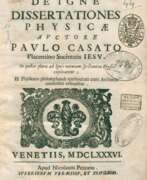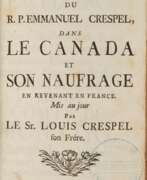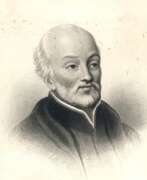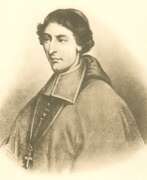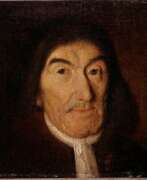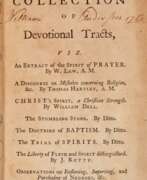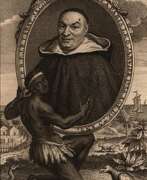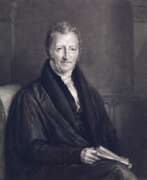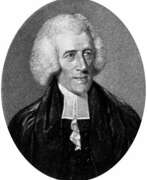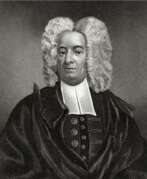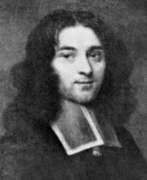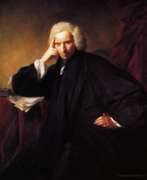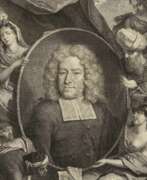Priests 18th century
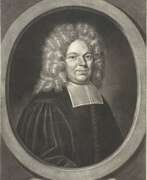

Jacques Basnage de Beauval was a French theologian and historian, diplomat and writer.
His father was a prominent lawyer and his grandfather and great-grandfather were pastors, Jacques studied theology and languages at the Academy of Saumur, then at Geneva and Sedan. In 1676, Jacques Basnage was appointed pastor at Rouen during the revocation of the Edict of Nantes, was forced to flee France for Holland, where he worked as a theologian, polemicist, historian, and diplomat in the service of the Grand Pensioner Hensius.
In 1717, on behalf of Holland, Basnage was sent to sign the treaty of the Triple Alliance (France, Holland, England). In the Annals of the United Provinces (1719-1726), compiled from the peace negotiations held at Münster, he displays breadth of vision, wisdom, and impartiality.
About 1719 Jacques Basnage was appointed historiographer of the Dutch states. He wrote several books on the Bible, the history of the Church, and the history of the Jewish people. Among the best known of these are his History of the Religion of the Protestant Denominations (1690), History of the Church of Jesus Christ to the Present Time (1699), written from Protestant positions, and History of the Jews (1706), as well as Jewish Antiquities, or Critical Notes on the Republic of the Jews (1713).
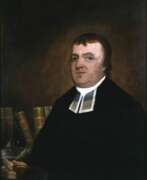

Jeremy Belknap is an American clergyman, historian, and author.
Belknap was educated at Harvard College and has devoted his life to the Congregationalist Church. In addition, he served for many years as secretary to the New Hampshire Ministerial Convention. He traveled throughout the state in his service and at the same time collected information on New Hampshire history. The result of these years of work was The History of New Hampshire, published in three volumes between 1784 and 1792. This work is the first modern history written by an American.
Belknap also wrote and published American Biographies in two volumes (1794 and 1798), which brought him to the attention of intellectuals across the country. He became a member of the American Philosophical Society and the American Academy of Arts and Sciences. Belknap was also a founding member of the Massachusetts Historical Society, the first such society in America.
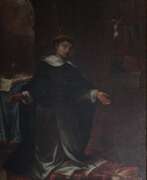

Benito Rodríguez Blanes was a Spanish Baroque painter and Catholic priest, celebrated for his contributions to the Granada School of art. Born in Granada and living through the 17th and early 18th centuries, Blanes became an influential figure in Spanish Baroque painting. He is noted for being a follower of Alonso Cano, a prominent painter of the time.
Blanes' artistic work, deeply rooted in religious themes, is distinguished by its spiritual depth and intricate detail. His works include beautiful paintings of the Virgin Mary, which were once located in the staircase of the archbishop's palace, and the sacristy of the Discalced Carmelites in Granada. Particularly notable are his paintings at the Museo de Bellas Artes de Granada, including a revered depiction of a Dominican saint.
For art collectors and experts, Blanes' works remain a testament to the rich cultural and artistic heritage of the Granada School. His paintings offer a glimpse into the spiritual and artistic expressions of his era.
To stay informed about new product sales and auction events related to Benito Rodríguez Blanes, sign up for our updates. This subscription is a must for enthusiasts and collectors interested in the pivotal figures of Baroque art and the Granada School.
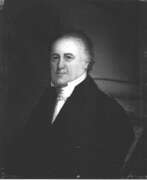

Stephen Burroughs was an American adventurer and con man, impostor and counterfeiter who became a writer and preacher.
Stephen Burroughs as a child moved to Hanover, New Hampshire, and as a child earned and proudly carried the reputation of an incorrigible bully, everywhere and always looking for trouble. During the Revolutionary War at the age of 14, he ran away several times, then in the Continental Army, then left it. In the eyes of society Burroughs was a scoundrel: a fugitive, a deserter, pretended to be a ship's doctor, a pastor, escaped from several prisons, including the island fortress and even by burning the prison. The fame of his exploits often ran ahead of himself.
Stephen later moved to Canada and led a group of counterfeiters, and a few years later suddenly decided to reform himself and became a youth pastor.
By the age of 33, Burroughs had accomplished so many daring "feats" and adventures that he decided to write a story about himself in his own words. His full of adventures book "Memoirs of the Notorious Stephen Burroughs" was published in 1798 and then reprinted under different names many dozens of times. And Burroughs himself died in 1840 in Canada as a free and wealthy man.
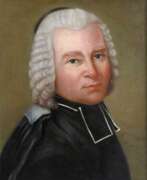

Nicolas-Louis De la Caille was a French astronomer, abbot and educator.
He studied philosophy and theology, became an abbot, but the craving for science overpowered everything, and he studied astronomy on his own. In 1736, la Caille received a place at the Paris Observatory, in 1739 was appointed professor of mathematics at Mazarini-College in Paris and built his own observatory, where he conducted astronomical observations. In 1741 Lacaille was admitted to the Académie des Sciences.
La Caille was an outstanding astronomer: he observed more than 10,000 stars in the Southern Hemisphere and named 14 of the 88 constellations. In 1752, he made an astronomical expedition to the Cape of Good Hope, where he built an observatory and conducted a huge series of observations, including the discovery and cataloging of 42 nebulae. These studies led to la Caille being called "the father of southern astronomy," and his observations from South Africa of the Moon, Venus, and Mars, combined with similar observations already made in the Northern Hemisphere, led to the calculation of more accurate values for the distances to these bodies.
On his return to Paris two years later, in 1754, he resumed his post and taught at the school of Mazarin, continuing his work at the observatory of the College of Mazarini. Among his pupils was the great chemist Antoine Lavoisier. La Caille was a foreign honorary member of the St. Petersburg Academy of Sciences and a member of the Royal Society of London. His Coelum Australe Stelliferum ("Star Catalog of the Southern Sky") was published in 1763.
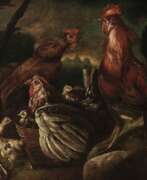

Giorgio Duranti was an Italian painter and cleric of the Baroque period, mainly active in Brescia. An entry in Dandolo's study of the late Venetian Republic states a 1755 as year of death, and that many of his works were in the Royal Gallery of Turin, which was the nucleus of the Sabauda Gallery.
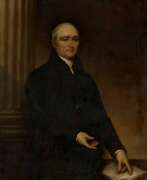

Timothy Dwight IV was an American clergyman, teacher, author, and satirical poet.
Dwight was the eldest son of farmer and merchant Timothy Dwight III. He graduated from Yale University, was a schoolmaster, a Massachusetts state legislator, and a chaplain in the Continental Army. In 1783 he opened a successful school in Greenfield Hill, Connecticut, where he became pastor of the Congregational Church.
In Connecticut, Dwight began writing poetry, such as Greenfield Hill (1794), and epics, including The Conquest of Canaan (1785), an allegory of the conquest of Connecticut from the British. His works are characterized by moralizing and moralizing. Dwight was also the author of political satire, as well as a verse satire on Voltaire, "The Triumph of Infidelity." He and his brother Theodore were members of a group of writers known as the Hartford Witters, centered around Yale University.
From 1795 to 1817. Dwight served as president of Yale University and was extremely influential in modernizing the curriculum. He was an active and eloquent professor of theology; his sermons were published in Theology; Explanation and Defense, 5 volumes (1818-19).
Dwight was also a member of the American Academy of Arts and Sciences and an early member of the American Antiquarian Society.
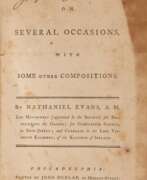

Nathaniel Evans was an American colonial clergyman and poet.
Evans was born in Philadelphia in the family of a merchant, graduated from the William Smith Academy in that city. In 1765 he received a master's degree from the University of Pennsylvania. In the same year he edited a collection of poems by his friend Thomas Godfrey. He also organized churches in Waterford and Gloucester, New Jersey.
Nathaniel Evans died of tuberculosis after living only 25 years, so his poetic talent remained undiscovered. But from a collection of a few of his poems published in 1772, we can tell that his mind was of a fine and refined stock, and his imagination was vivid.
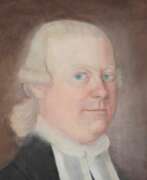

Enos Hitchcock was an American clergyman, author, educator, and education advocate.
He graduated from Harvard College and soon began preaching. When hostilities between the colonies and Great Britain broke out in 1775, Hitchcock joined the army, serving as a chaplain in the Continental Army from 1779-1780. After the war ended, Rev. Hitchcock preached in various localities until he settled in Providence, NC, in 1783 as pastor of the First Congregational Church, becoming an active member of its benevolent society.
In 1788 Hitchcock received his doctorate from Brown University and maintained close ties with it thereafter. With the president of that university, James Manning (1738-1791), and other prominent citizens of Providence, he was active in educational matters, and by the time of his death had succeeded in establishing a public school system in Providence. In addition to these activities, Rev. Hitchcock was a member of the Pennsylvania Society for Promoting the Abolition of Slavery.
Enos Hitchcock also wrote several epistolary works in which, among other things, he objected to the use of suicide as a plot point. His bullied rural heroes and heroines are ultimately rewarded for their virtue and courage.
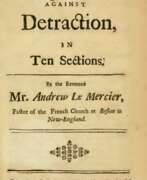

Andrew Le Mercier was a clergyman, pastor of the French Huguenot Church in Boston in the 18th century, and writer.
Le Mercier completed his ecclesiastical training at the Geneva Academy and in 1716 arrived in Boston (Massachusetts Bay, then an English colony) and began working as a pastor. He was active in establishing a settlement for shipwrecked men on the infamous Sable Island. The pastor also sent provisions there, which saved many lives.
Andrew Le Mercier wrote The Ecclesiastical History of Geneva in Five Books, with a Political and Geographical Description of that Republic (Boston, 1732) and A Treatise Against Diminution (1733).
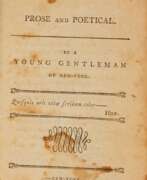

John Blair Linn is an American priest and poet.
Linn graduated from Columbia College and later became a priest. While in college, he published in magazines and newspapers, later writing a play and several collections of poetry and prose.
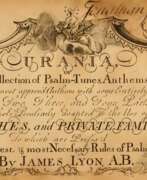

James Lyon was a clergyman and one of the first American composers.
James Lyon was one of the few composers in mid-eighteenth-century America. He earned a master's degree from the College of Philadelphia and became a Presbyterian minister. He is known to have begun writing music while still a student. While living in Philadelphia, Lyon published his Urania, or Select Collection of Psalms, Hymns, and Anthems, in 1761. It contained many English tunes as well as six original pieces by Lyon. Lyon is believed to be the author of the tune that eventually became the song "America (My Country 'Tis of Thee)."
He served the Congregational Church in Machias, Maine from 1771 until his death in 1794. James Lyon was an ardent and active patriot and even made George Washington a detailed proposal to conquer Nova Scotia.
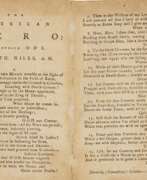

Nathaniel Niles is an American lawyer and politician, a member of the House of Representatives from Vermont.
Niles attended Harvard College and the College of New Jersey, eventually becoming a preacher but also active in politics. Niles sat in the lower house of the Vermont legislature for eight terms. From 1784 to 1787 he was a member of the state supreme court.
In addition to his sermons, he published numerous theological articles. When the American Revolution broke out in 1775, Niles enthusiastically supported the war against England. He even wrote his only work of poetry, an ode entitled "American Hero," to commemorate the Battle of Bunker Hill, which was set to music and became quite popular among New England soldiers and militia.
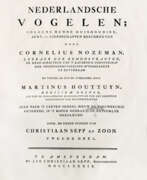

Cornelius Nozeman was a Dutch church minister and ornithological naturalist.
Nozeman was the inspiration for the best Dutch work on ornithology of the 18th century. This long-term project took more than 60 years in total to complete. The work, entitled Nederlandsche Vogelen ("Birds of the Netherlands"), was begun in 1770 by two Dutch craftsmen. The famous engraver and painter Christian Sepp drew the illustrations, and Nozeman wrote the text for the first two volumes. After the death of Nozeman and Sepp, the work on the publication of the work was continued by their successor, physician and biologist Martinus Houttuyn. This voluminous and unique work was completed in 1830 by Christian Sepp's son Jan Christian, a natural history publisher, and his grandson Jan Sepp.
Each volume of this five-volume work of science and art contains 50 images of bird species, and each species is described on several pages.
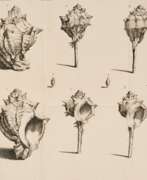

Giovanni Vincenzo Petrini was an Italian priest and theologian, philosopher, mathematician, and expert in mineralogy.
Along with Scipio Breislacus, Petrini was one of the founders of Italian volcanology. He taught philosophy and mathematics, theology, but specialized in mineralogy and created the Mineralogical Cabinet in Nazareth. This museum was famous in Europe and was visited, among others, by Emperor Joseph II, who gave him rare specimens from the lands of the Empire and especially from Hungary.
Giovanni Petrini was the author of the catalog Gabinetto mineralogico del Collegio Nazareno ("The Mineralogical Cabinet of the Nazarene Collegium, described by external features and distributed by component parts" (Rome, 1791-1792). The specimens in it are classified according to a standard structure: salts, earths, bitumens, combustibles, and metals. There is also a section on gemstones.
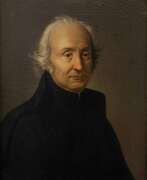

Giuseppe Piazzi was an Italian astronomer, mathematician and priest.
Around 1764 Piazzi became a Theatine priest, in 1779 he was appointed professor of theology in Rome, and in 1780 - professor of higher mathematics at the Academy of Palermo. Later, with the assistance of the Viceroy of Sicily, he founded an observatory in Palermo. There he compiled his great catalog of the positions of 7,646 stars and showed that most stars move relative to the Sun. There, on January 1, 1801, Piazzi also discovered the asteroid Ceres.
Giuseppe Piazzi's merits were appreciated: he was a member of the Royal Society of London, a foreign honorary member of the St. Petersburg Academy of Sciences and a foreign member of the Paris Academy of Sciences. A crater on the Moon is named in his honor.
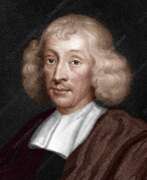

John Ray was a British clergyman, naturalist, botanist and zoologist, and a Fellow of the Royal Society of London.
He came from a poor family, but through his persistence in acquiring knowledge he achieved recognition as a scientist. Ray published important works on botany, zoology, and natural history. His classification of plants in Historia Plantarum was an important step toward modern taxonomy (the scientific study of naming, defining, and classifying groups of biological organisms based on common characteristics). John Ray was the first to provide a biological definition of the term "species."
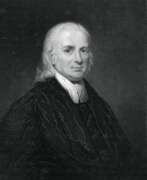

Christian Friedrich Schwarz was a German Lutheran missionary to India, a polyglot and diplomat.
Schwarz knew many languages, including Hebrew, Greek, Sanskrit, and Persian. Very young, he set out on a mission to India in early 1750 and was very successful. Schwartz was favorably received by Indian royalty, he taught Raja Serfoji of Tanjore, and was greatly respected by the local people for his good works.
The results of Christian Schwartz's missionary work exceeded all expectations. Schwartz founded several schools in India and had a significant impact on the establishment of Protestant Christianity in southern India. He lived in India until the end of his life and was buried with honors at St. Peter's Church in Maharnonbuhavadi, Thanjavur.
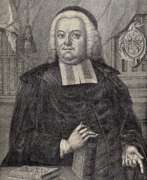

Heinrich Jacob Sivers was a German Evangelical Lutheran theologian and scholar, poet and writer, naturalist and collector.
Sifers studied law and theology at the University of Kiel, and received his doctorate at the University of Rostock, where he lectured and wrote various works. He wrote many poems, sermons and ceremonial speeches in German, Swedish and Latin.
Heinrich Sivers also studied geology, traveled extensively in Scandinavia, and compiled his own mineral collection. In 1737 he sold many of his minerals, as well as a cabinet of Roman coins to Count Carl Gillenborg, today they can be seen at Lund University.
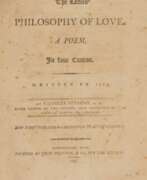

Charles Stearns was an American clergyman and doctor of philosophy.
Rev. Charles Stearns graduated from Harvard College and served the Congregational Church in Lincoln from late 1781 until his death. Several of his sermons were printed in the early 19th century.
In addition, Stearns was principal of the Liberal School, which opened in early 1793, a relatively progressive coeducational institution. While working at the school, Stearns wrote and published a number of works related to education, including Dramatic Dialogues for the Use of Schools (1798), a collection of thirty original plays that were performed by students.
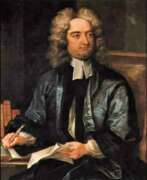

Jonathan Swift was a British-Irish writer, essayist, philosopher, and author of the world-famous satirical novel Gulliver's Travels.
Swift also wrote numerous works, including The Tale of the Barrel (1704), An Argument Against the Abolition of Christianity (1712), and A Modest Proposal (1729). Almost all of Swift's satirical works were published anonymously, giving the author wide latitude in expressing his talent as a satirist.
Swift was a clergyman, made a career in London, became the chief pamphleteer and political writer of the Tories and headed the Tory journal "The Inspector", and then returned to Ireland, where he created his major life's work.
The four-part novel Gulliver's Travels, Jonathan Swift's greatest satire, was first published in 1726 and has since been reprinted hundreds of times in many languages around the world. The author describes in an engaging style the different races and societies that Gulliver encounters on his travels to ridicule the many errors, follies, weaknesses and vices to which people and society at large are subject. The author's boundless imagination, bitter irony, keen intellect and brilliant language give this work a world-class scope.
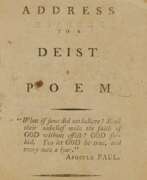

Joseph Vaill, Jr. was an American clergyman.
Vaill graduated from Dartmouth College in Hanover, NH, was appointed pastor of the Hadlyme Congregational Church in 1780, and served for 58 years. Rev. Joseph Vaill also engaged in missionary work and published his sermons.
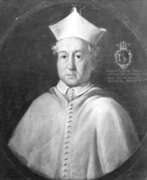

Johann Zahn (German: Johann or Johannes Zahn) was a German scientist and philosopher, optician and astronomer, mathematician and inventor.
Zahn studied mathematics and physics at the University of Würzburg, was professor of mathematics at the University of Würzburg, and served as a canon of the Order of Regular Canon Premonstratensians. His other activities were optics as well as astronomical observations.
In 1686 Johann Zahn invented and designed a portable camera obscura with fixed lenses and an adjustable mirror, which is the prototype of the camera. In his treatise on optics, Oculus Artificialis Teledioptricus (1702), Zahn gives a complete picture of the state of optical science of his time. He begins with basic information about the eye and then moves on to optical instruments. The book is aimed at eighteenth-century microscope and telescope enthusiasts and includes all the necessary details of construction, from lens grinding to drawings.
